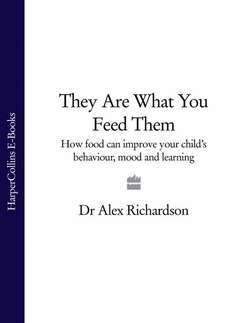Читать книгу They Are What You Feed Them: How Food Can Improve Your Child’s Behaviour, Mood and Learning - Dr Richardson Alex - Страница 42
Common Indicators of ADHD
ОглавлениеIn ADHD children, many of the following features or ‘symptoms’ occur much more than expected for the child’s age and developmental level. They also occur persistently, both over time and across different situations.
Attentional Problems
Makes careless mistakes in schoolwork and other activities, and doesn’t give close attention to detail.
Has difficulty organizing tasks and activities
Forgetful in day-to-day activities (often loses ‘tools’ for a job, e.g. pencils, ruler, homework diary)
Has difficulty sustaining attention in work or play. Even if instructions are understood, and intentions are good, they’re not followed through
Doesn’t like sustained mental effort and may try to avoid it
Often ‘daydreams’ (may appear to be ‘elsewhere’ when spoken to)
Is easily distracted from a task by other things that are going on
Hyperactivity/Impulsivity
Runs about or climbs when it’s not appropriate to do so
Fidgets, squirms or shows other signs of restlessness
Has difficulty sitting or playing quietly
Talks or chatters excessively
Interrupts questions, conversations or games, and has difficulty waiting for his turn
Shows impulsive behaviour in other ways: can’t restrain himself, and often acts without thinking (may appear unaware or careless of potential dangers)
The consensus is that full-blown ADHD affects around 1 child in every 20 (5 per cent), but in some parts of the US up to 20 per cent of children are medicated with stimulant drugs (such as Ritalin) for the condition. Diagnosing ADHD properly involves ruling out some other medical conditions that can mimic it, including some hormonal and metabolic disorders, infectious diseases, neurological disorders, blood diseases, metal intoxications, cancers, genetic disorders, and various other disorders! In reality, resources are scarce (and stimulant drugs are cheap), so I’m sorry to say that in my experience this kind of detailed examination and testing certainly does not usually happen.
The ‘ADHD’ label can cover a multitude of different things. Any co-existing conditions can make a big difference; and either hyperactivity-impulsivity without inattention, or attentional difficulties without hyperactivity both fall into this same diagnostic category. (There used to be a separate label for the latter—Attention Deficit Disorder, or ADD.) This huge variability between different children who are given the ADHD label guarantees that no single management approach is going to ‘work’ with all of them. However, the first thing that’s usually offered to parents if a child receives this diagnosis is stimulant medication.7
I am not opposed to medication for ADHD, when it is clearly warranted—as I think it can be for some children—but I do think that it should always be the last resort, not the first.
We often hear that around 70 per cent of children with ADHD get at least some benefits from stimulant medications. That’s very impressive, but it still leaves 3 children in every 10 who gain nothing from this kind of treatment—and many parents are understandably worried about possible side-effects, which can include difficulties with appetite and sleep, stunted growth, undesirable mental symptoms and increased risks of certain physical disorders. Any ‘benefits’ are also limited to behaviour, as no advantages for academic achievement have ever been demonstrated from the use of stimulant medications. (If they behave better and concentrate better, why don’t they learn better?)
Most children can pay attention in at least some situations—it just depends on what these are, how motivated the child feels (what’s the pay-off for him?), and what the child’s perception is of the situation and his role in it (what demands does he feel under, and whom is he trying to impress?).
‘…all that was needed was to change the ‘‘pay-off’’ [in a test], so that the child who tried to rush through the test without even trying would pay a worse penalty than the one who spent time trying to work out the correct answer. This time, the computer would not move on to the next item until some time had elapsed (the time that most non-ADHD children would spend, on average, trying to solve the problem). For any child who just pressed the button early, their reward was to have to look at a blank screen for the rest of the time period. The next item would appear no sooner that it would have done in any case. Under these conditions, the well-known “deficits” of the ADHD children simply didn’t show up!’
What we don’t usually hear is that in certain subgroups the proportion who benefit from stimulant medications is much lower. For example, it may drop to 30 per cent for children with anxiety as well as ADHD (and some evidence suggests that negative side-effects may be more likely in these children).8 In other words, for 7 out of 10 of these anxious, often ‘moody’ ADHD children, stimulant drugs may be no use at all.
Before accepting any stimulant drugs for your ADHD child, or antidepressants, do make sure that ‘bipolar disorder’ has been ruled out. A large-scale survey of parents of bipolar children concluded that children with undiagnosed bipolar disorder can sometimes be ‘thrown into manic and psychotic states, become paranoid and violent…unstable and suicidal…’ if they are given these drugs before their mood has been stabilized.9 Worryingly, they suggest that one-third of all children diagnosed with ADHD in the US are actually suffering from early symptoms of bipolar disorder. According to the American Academy of Child and Adolescent Psychiatry, ‘…a third of the 3.4 million children who first seem to be suffering with depression will go on to manifest the bipolar form of the disorder’. If medications are to be used, it’s worth making sure they’re the right ones.
